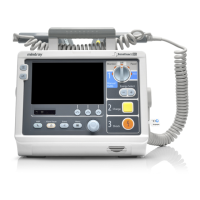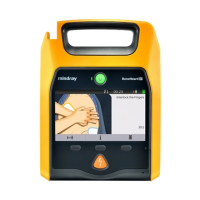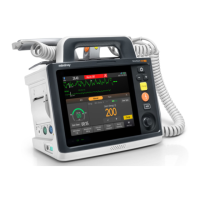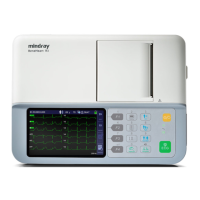Defibrillator/Monitor Operator’s Manual 12 - 3
■ Interfering substances:
◆ Intravascular dyes (such as indocyanine green, methylene blue, indigo carmine, etc.)
◆ Dyes in the measure site, such as nail polish.
■ Environmental conditions:
◆ Excessive ambient light
◆ Electrosurgery equipment. The pulse oximeter may be used during electrocautery, but this may affect
the accuracy or availability of the parameters and measurements.
◆ Defibrillation (may cause inaccurate reading for a short amount of time)
◆ Excessive patient/sensor motion
◆ Electromagnetic field
◆ Arterial catheters and intra-aortic balloon
■ Others
◆ Inappropriate positioning of the SpO
2
sensor, or use of incorrect SpO
2
sensor
◆ Cuff or arterial blood pressure measurement device on the same limb as the SpO
2
sensor.
12.5 SpO2 Display
• PI is only available for Masimo SpO
2
.
(1) Pleth waveform (Pleth): visual indication of patient’s pulse. The waveform is not normalized.
(2) SpO
2
unit
(3) SpO
2
alarm limits
(4) Oxygen saturation of arterial blood (SpO
2
): percentage of oxygenated hemoglobin in relation to
the sum of oxyhemoglobin and deoxyhemoglobin.
(5) Perfusion indicator: the pulsatile portion of the measured signal caused by arterial pulsation.
(6) Perfusion index (PI): gives the numerical value for the pulsatile portion of the measured signal
caused by arterial pulsation. PI is an indicator of the pulsatile strength. You can also use it to
assess the SpO
2
signal strength.
◆ If the “SpO2 Low Perf” alarm persists, reposition the SpO
2
sensor or find a better site.
◆ If low perfusion persists, choose another method to measure oxygen saturation if possible.

